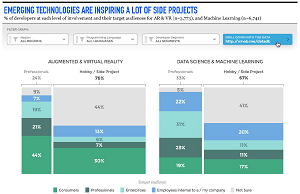News
Dev Survey Examines What's Next on the Cutting Edge
- By David Ramel
- August 8, 2016
To see what's next for developers on the cutting edge of technology, you probably need only look out the window to see the hordes of younger-types walking around public places with their heads buried in their smartphones.
Or you can consult the latest developer survey from Visionmobile Ltd., which reports on "augmented reality" -- the magic formula behind Pokémon Go, the wildly popular new mobile game all those youngsters are playing -- and other new-age targets of modern development.
In addition to augmented reality (AR) and virtual reality (VR), Visionmobile focused on data science and machine learning (ML), with a brief nod to messaging bots.
They're examined in the new report, State of the Developer Nation Q3, 2016 report (free upon providing registration info), from Visionmobile, based on surveys of more than 16,500 respondents doing mobile, desktop, cloud and Internet of Things (IoT) development (we earlier reported how the survey described the mobile OS wars -- Android is winning).
One interesting finding in the report is that cutting-edge hype doesn't always equate with the cutting-edge reality found the development front lines.
"None of these are new areas of technology but all have become more prominent thanks to technical developments, sparking new focus and attention," Visionmobile said. "Is all the media hype reflected in developer activity? Certainly the two are not proportional. The messaging bot hype has been at fever pitch in recent months [like, for example, here], and yet there's relatively little developer activity so far. At the other end, machine learning is probably the least hyped of the three and has the most developer activity."
Concerning changed reality, Visionmobile characterized AR and VR as battling to become the next digital interface, a space in which AR might have the edge due to its capability of being used almost anywhere. "Strapping on a VR headset and stepping into a virtual world is unlikely to be something most people will do in public places anytime soon," said the company, which acknowledged VR might change industries such as entertainment, communications and education.
 [Click on image for larger view.]
Looking at Augmented and Virtual Reality, Data Science and Machine Learning (source: Visionmobile)
[Click on image for larger view.]
Looking at Augmented and Virtual Reality, Data Science and Machine Learning (source: Visionmobile)
The report noted that many industry heavyweights -- including Facebook, Microsoft and Google -- are investing in VR and AR, exhibiting support for an altered-reality future.
"The question is whether the third party developers that create all the content and services believe in this future too?" the report said. "With nearly 23 percent of the developers who took our survey already involved in either AR or VR development, it seems that they really do. Most of those developers are very recently involved and 76 percent of them only as a hobby or side project. This is the way we usually see new technology areas explored when the commercial reality doesn't yet support many paid jobs.
"The other thing our data points to is that these developers think it will be a consumer-first market. 44 percent of professionals in this sector are targeting consumers versus only 19 percent targeting enterprises. While AR smartphone apps occasionally take off, like the current Pokémon Go craze, for these technologies to reach their potential new personal hardware will be required. This does point quite strongly to the consumer market as the place to gain initial traction."
Visionmobile also examined how data science and ML go hand-in-hand, with ML used to self-learn about data structures to better help data scientists make analytical sense out of such structures and thus create business-actionable insights -- or "to have the computer analyze the data and figure out what's important."
"Data science and machine learning in general have been helping companies do more with their data for several years now, so the fact that 41 percent of the developers in our latest survey are involved in some way makes sense too," the report said. "33 percent of them are professionally involved, and they show more of a bias towards enterprise and internal audiences. If we look at the hobby and side project activity it's clear that a lot of developers are just learning the ropes. 41 percent are not sure what audience they're targeting, typically suggesting a pure technology exploration."
Visionmobile noted that open source toolkits for the Python and R programming languages popular in data science and ML, with technologies such as Google's TensorFlow possibly gaining interest.
"The huge interest in AR, VR and machine learning, when compared to the relatively tiny activity levels in messaging bots, is perhaps in recognition of their significance," the company said. "Indeed, unless we integrate computing directly with our thoughts, AR might be the final interface paradigm. Similarly machine learning is likely to be a central part of most of the really important systems created in the future. It'll be the magic behind many amazing new products and the automating force that comes to replace many white collar workers."
But not, one would hope, developers.
About the Author
David Ramel is an editor and writer for Converge360.